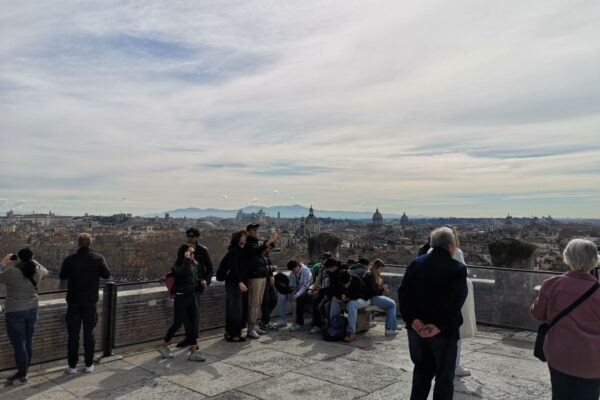If you got this far, it was certainly curiosity towards one of Rome’s most famous bridges that guided you: the Ponte Sant’Angelo.
Don’t worry, you’re just in the right place! After reading this post, you will know everything there is to know about this marvel of Italian architecture.
Starting from the original core of Ponte Elio, at a time when the cult of the ancient gods left no room for saints or angels, we will see it transform into the medieval Ponte San Pietro, and later still into the Ponte degli Angeli we know today.
We will follow the historical events of Castel Sant’Angelo and the Eternal City and see how these, over time, have been reflected in the structure and decorations of the bridge.
Together we will discover the history of the many sculptures that have adorned it, talk about the most famous statues, and linger over the description of the architectural wonders and sculptural wonders that make Ponte Sant’Angelo one of the most famous and beautiful bridges in Italy and the world.
I beg your pardon? Have I aroused your curiosity yet? Very well, then let’s get started!
ALT! Before leaving with the article, I would like to give you a brief warning: given the celebrity of this splendid monument, to visit Castel Sant’Angelo you will certainly run the risk of running into a long queue at the ticket office. To enter this attraction and skip the queue, I advise you to buy your ticket directly online. Click below to book your entrance and enter Castel Sant’Angelo in the blink of an eye!
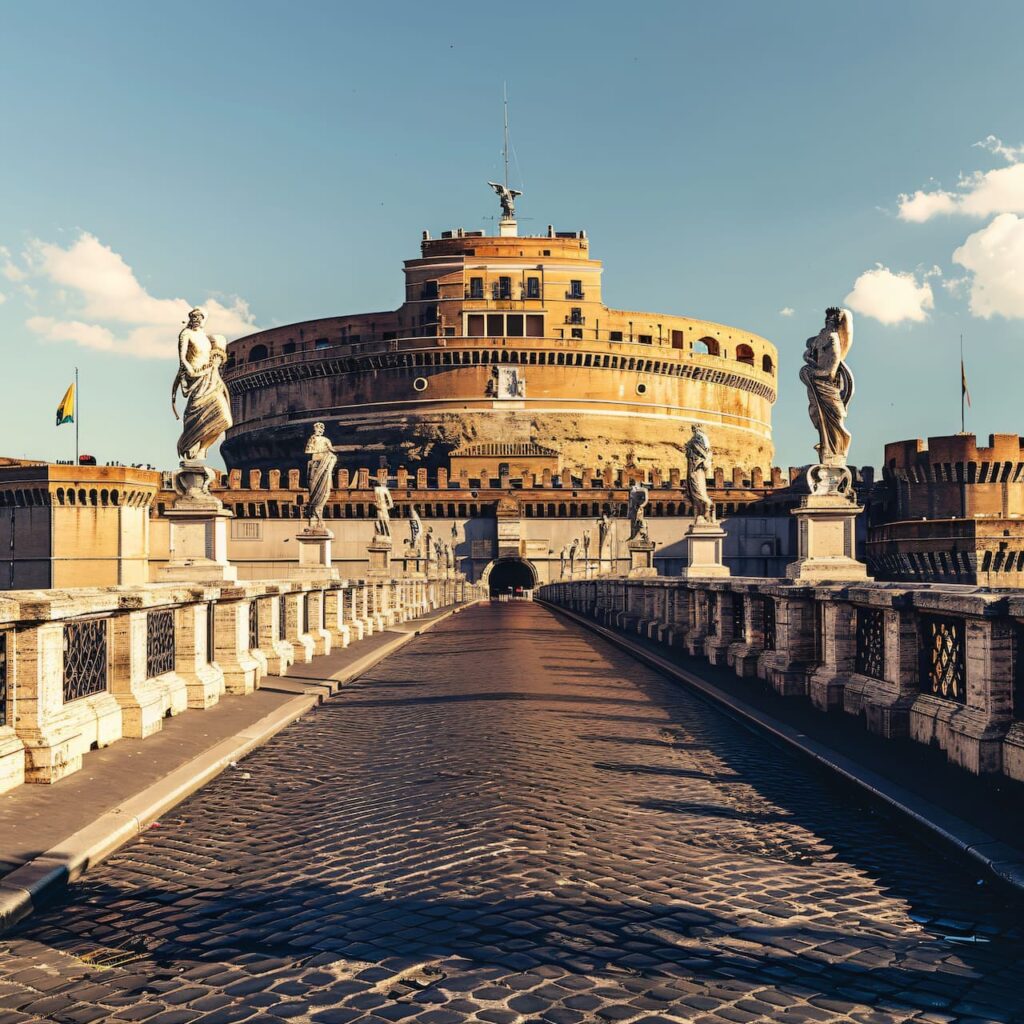
Castel Sant’Angelo Rome Tickets: Quick Access
Buy online. Choose your preferred time. Visit Rome’s Castel Sant’Angelo, Hadrian’s Tomb, the papal quarters, the fortress and much more.
You can cancel free of charge up to the day before the visit.
The Bridge of Angels Rome: description
Contents
Ponte Sant’Angelo, originally known as Pons Aelius (Helios Bridge) and Pons Hadriani (Hadrian’s Bridge) is one of the oldest and most famous bridges in Rome.
Situated between the districts of Ponte and Borgo, it was built around 134 AD by order of Emperor Publius Aelius Hadrian (from whom it takes its name) to a design by the architect Demetrius, with the function of connecting the Mole Adriana, today Castel Sant’Angelo, to the left bank of the Tiber river.
Consisting of five stone arches, three of which date back to Roman times, the bridge is famous for the statues of St. Peter and St. Paul at one end, as well as the ten statues of angels, designed by Giovan Lorenzo Bernini, that adorn the parapets.
Once a destination for pilgrims from all over the world, today it is visited by millions of tourists every year. The bridge is pedestrian-friendly and is freely accessible, twenty-four hours a day, even to people with disabilities.
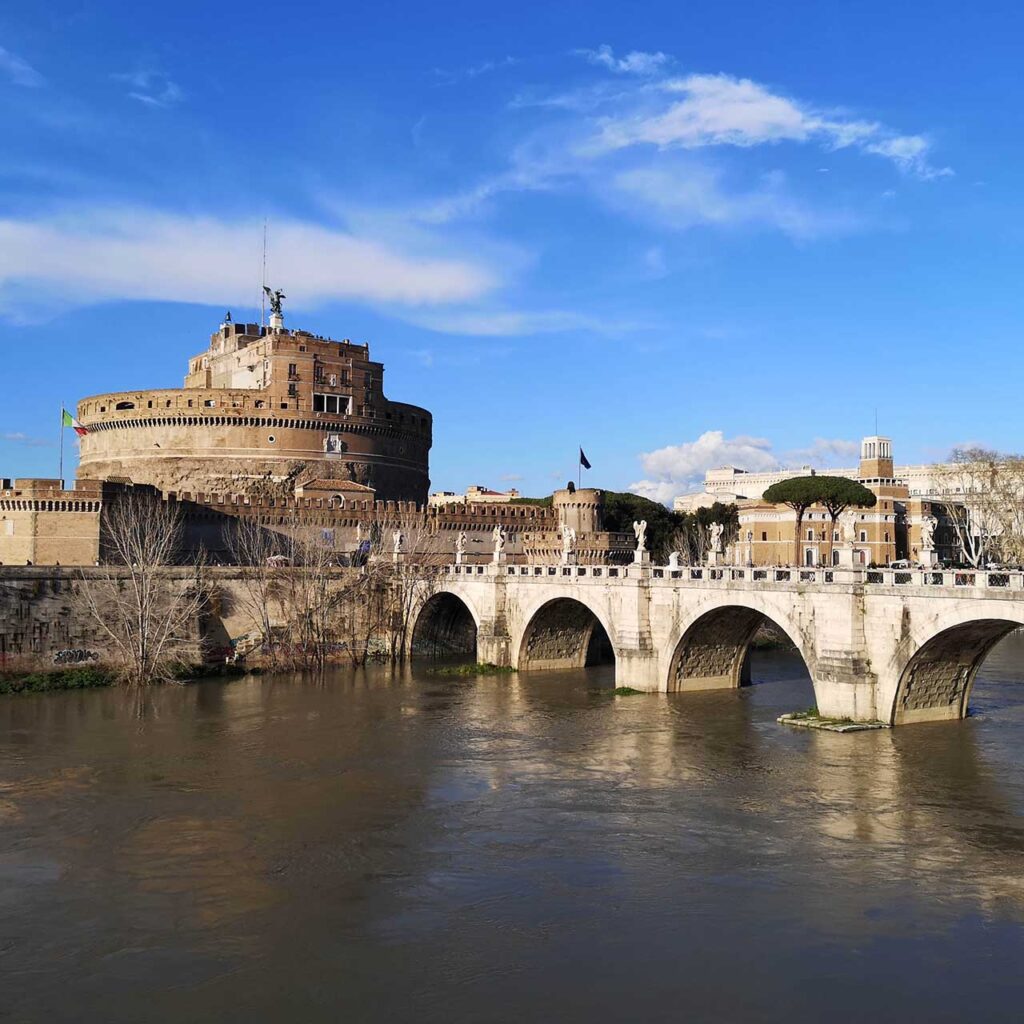
Ponte Sant’Angelo: History
The history of Ponte Sant’Angelo is naturally linked to that of the Castle from which it inherits its name. It all began between 123 AD and 135 AD, when the emperor Publius Aelius Hadrian ordered the architect Demeterianus to build a funeral mausoleum for himself and his family on the outskirts of Rome, in an area then known as ager Vaticanus.
And in the design of what was to become the Mole Adriana, built on the right bank of the Tiber River, there naturally entered into the project of a bridge connecting it to the Campo Marzio, in front of which it was built. In about 134 A.D. work was completed on a monumental bridge named after the emperor himself: the Aelius Bridge, or Aelius Bridge, or Aelius Bridge.
Constructed of peperino, a magmatic rock typical of Lazio, and covered with travertino, very similar to marble, it consists of three main arches and two smaller ones supporting the access ramps.
In the Middle Ages, the bridge was already a primary junction in the most important area of the city: in fact, it is the only one in ancient Rome that has remained intact, and it connects the town with the Vatican.
The region around the bridge has the highest population density, and its inhabitants are the wealthiest in the entire Eternal City.
Hordes of pilgrims cross Ponte Elio every day on their way to the ancient Basilica di San Pietro; they begin to refer to that passage as pons Sancti Petri, Ponte di San Pietro;
At the end of the 6th century, the bridge changed its name once again.
Legend has it that in 590 AD. the newly installed Pope Gregory the Great, at the head of a penitential procession he himself had called to ward off an epidemic, had a vision as he crossed the Aeolian Bridge: he saw the archangel Michael sheathing his sword at the top of the Mole Adriana before disappearing, and took it as a divine sign that the epidemic was now defeated.
Since then, the bridge has been named Ponte Sant’Angelo after the castle whose entrance it represents;
But after having witnessed a miracle, the bridge became the bearer of a tragedy: during the Jubilee of 1450 the balustrades gave way due to too many pilgrims.
The accident cost the lives of almost 200 people.
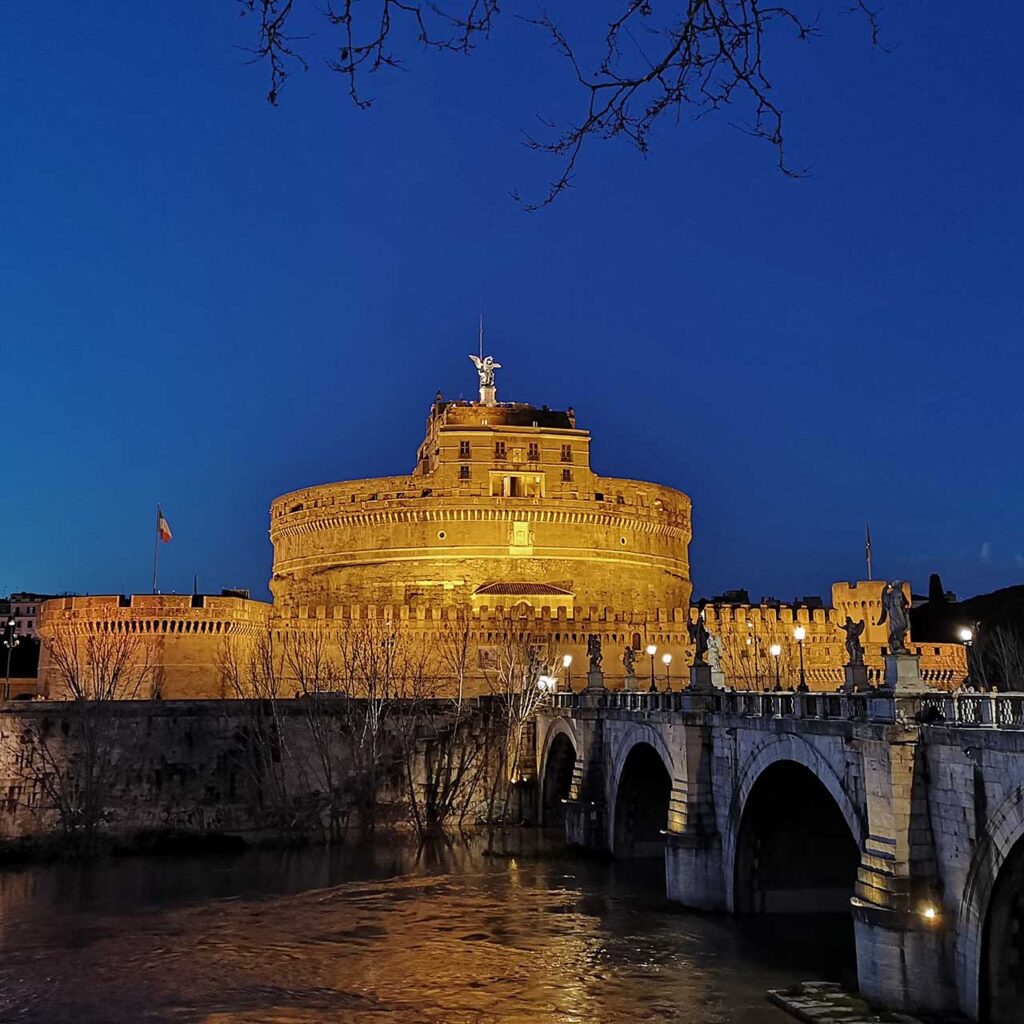
Following the incident, it was decided to knock down some houses at the head of the bridge, so as to facilitate the flux to the pilgrims and avoid other accidents.
In memory of the victims, Nicholas V had two chapels dedicated to St. Mary Magdalene and the Holy Innocents built on the bridge.
For many, many years St. Angelo Bridge was both the place of execution of death sentences and the place of exhibition of the bodies of the executed as a warning to the population.
It is said that in 1500, during the first exhibition, nine hanged men were hung at each entrance to the bridge, for a total of eighteen bodies.
In 1533 Pope Clemente VII ordered the destruction of the two small chapels and replaced them with two famous statues: we are talking about the statues of St. Peter, by Lorenzetto, and St. Paul, by Paolo Taccone.
Only three years later, on the occasion of the visit of Charles V of Spain, Paul III commissioned Raffaello da Montelupo eight stucco statues, depicting the four evangelists and the patriarchs Adam, Noah, Abraham and Moses, which, however, were soon destroyed.
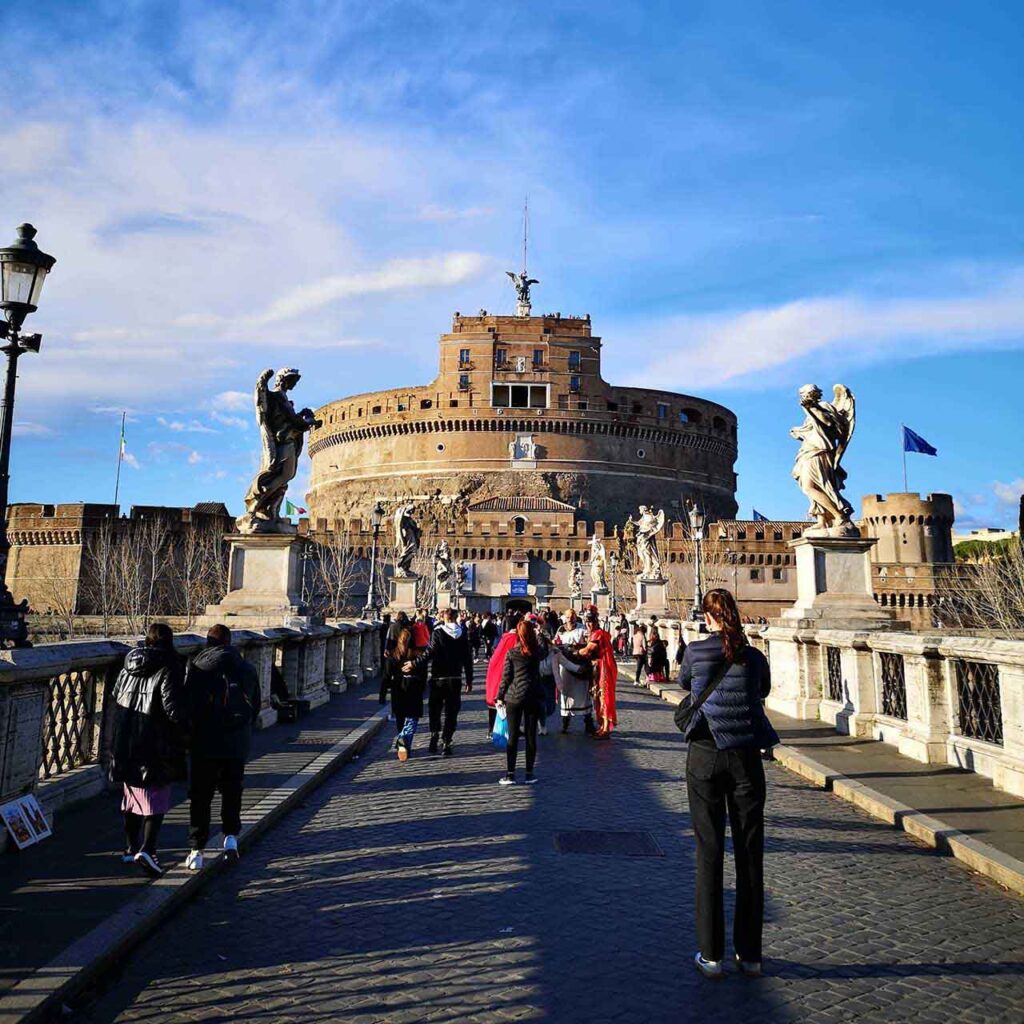
The new parapet, on the other hand, was commissioned in 1669 by Giovan Lorenzo Bernini at the behest of Pope Clemente IX.
In addition to a project for the general renovation of the bridge, Bernini was asked to design ten new statues to flank those of Peter and Paul.
Thus the monument gains its famous statues of Angels bearing the symbols of the Passion, made by Bernini’s pupils.
Two of these, the Angel with the scroll and the one with the crown of thorns, hand-carved by Bernini himself and his son Paolo, were immediately replaced by two workshop copies for fear that the weather would ruin them.
In 1892, construction work on the Lungotevere imposed major transformations on the High Bridge of Castel Sant’Angelo as well: the widening of the Tiber riverbed required the demolition of the access ramps and the addition of two arches, identical to the three main ones, at its ends.
The bridge, now made up of five masonry arches with five equal spans, thus took on the form it still retains today: 130 metres long and 9 metres wide, it is ready to welcome crowds of onlookers from all over the world.

Castel Sant’Angelo Rome Tickets: Quick Access
Buy online. Choose your preferred time. Visit Rome’s Castel Sant’Angelo, Hadrian’s Tomb, the papal quarters, the fortress and much more.
You can cancel free of charge up to the day before the visit.
Sant’Angelo Bridge Statues
On the parapets of Castel Sant’Angelo Bridge one can still admire the two imposing sculptures of Saints Peter and Paul, created by Paolo Taccone and Lorenzetto, and the ten marvellous statues of Angels designed by Bernini and made by his students.
The Statues of Saints Peter and Paul
At the entrance of the bridge we can admire the statues of St Peter and St Paul.
Sentinels of the Bridge of Angels, the two saints are depicted with their most famous symbols: St. Peter holds in his hand the Keys of Heaven, commonly known as the Keys to Paradise, the very ancient Christian symbol of the universal Church; while St. Paul holds a sword, a clear reference to the Letter to the Ephesians in which the saint himself uses it as an emblem of the fight against evil.
The two statues are also meant to be a reminder to anyone about to cross the bridge: at the base of the two, engravings in Latin read: ‘Hinc humilibus venia’ and ‘Hinc retributio superbis’, which we can translate as ‘Hence forgiveness for the humble’ and ‘Hence retribution for the proud’.
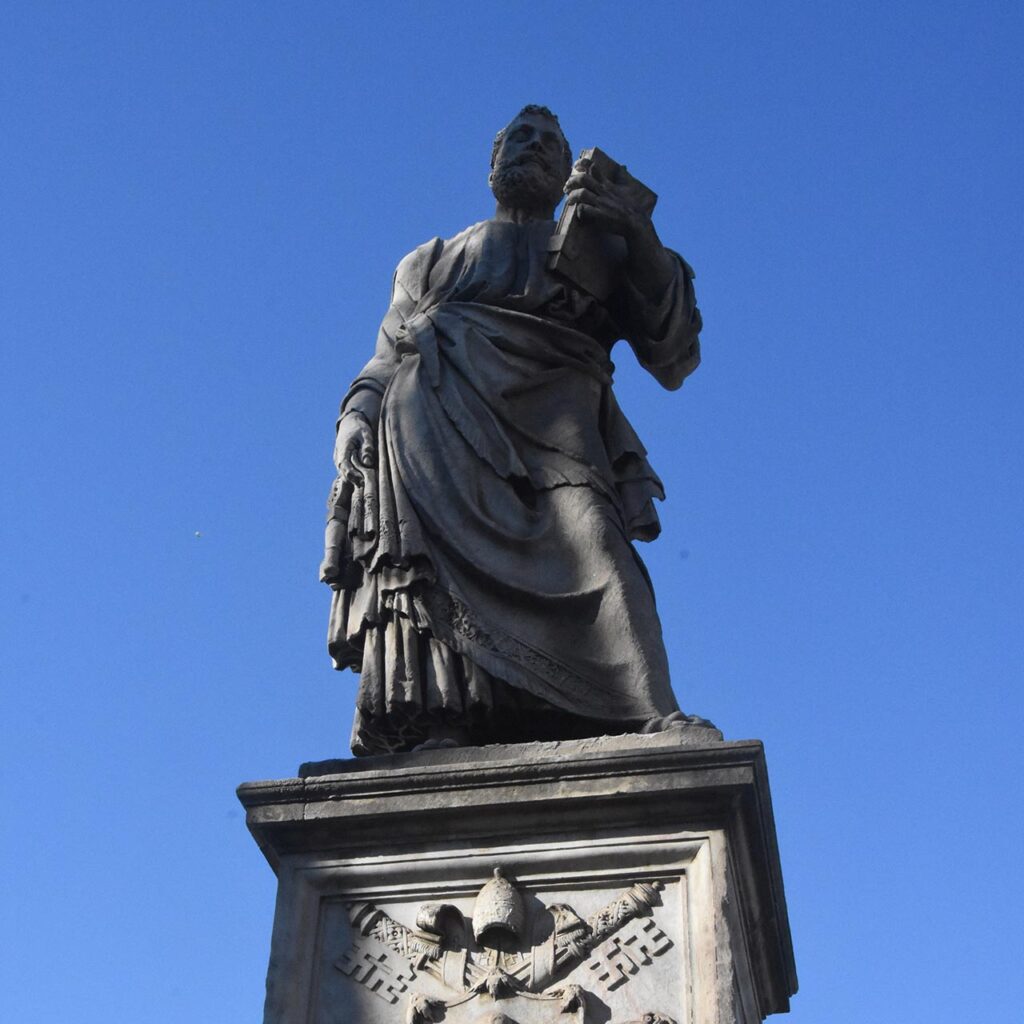
The Statues of Angels
Angel with column
The first angel, by Antonio Raggi, carries the column to which the Christ was chained to be whipped. The engraving at the base, taken from the Book of Sirach, reads “Tronus meus in columna“, or “My throne is in the column”.
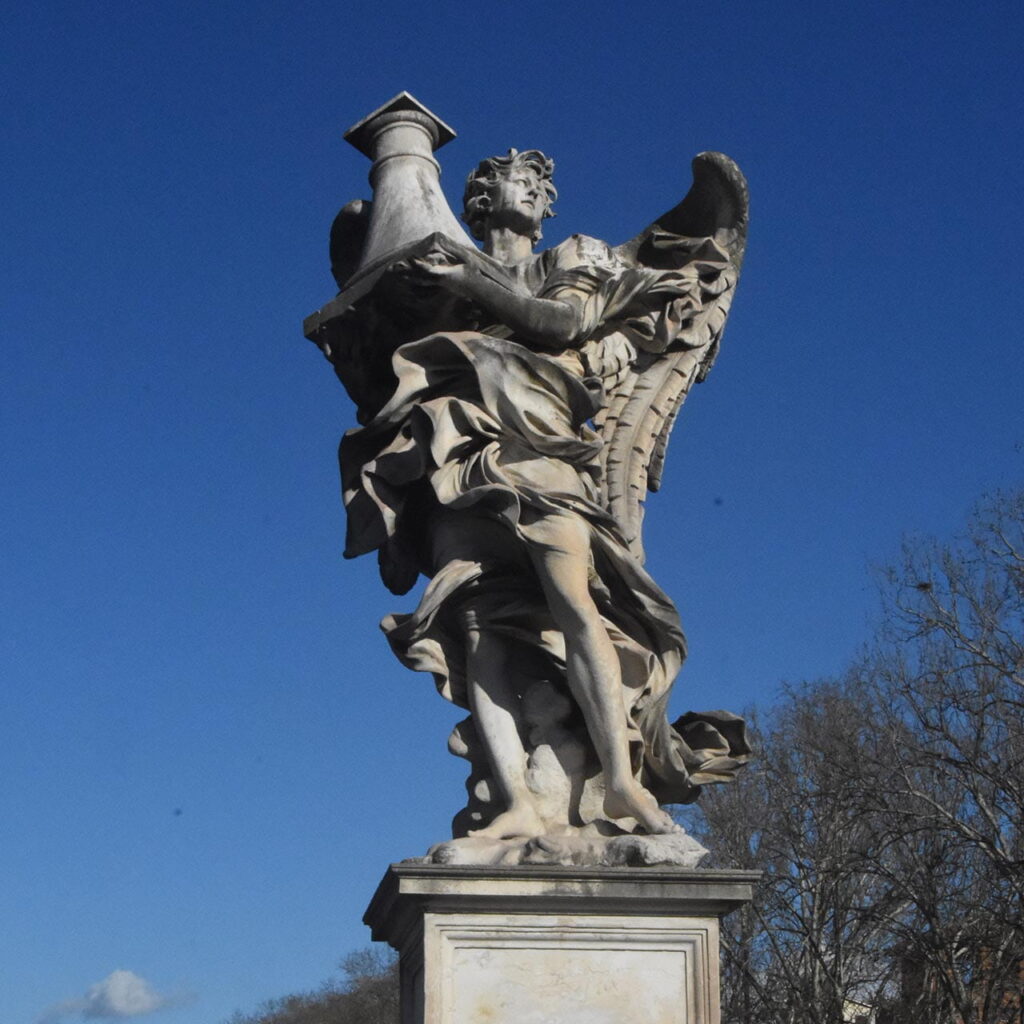
Angel with the scourge
The second angel, by Lazzaro Morelli, holds in his hands the whip used to flagellate Jesus tied to the pillar. The engraving at the base, taken from Salm 37, reads ‘In flagella paratus sum‘, or ‘I am ready for the scourge’.
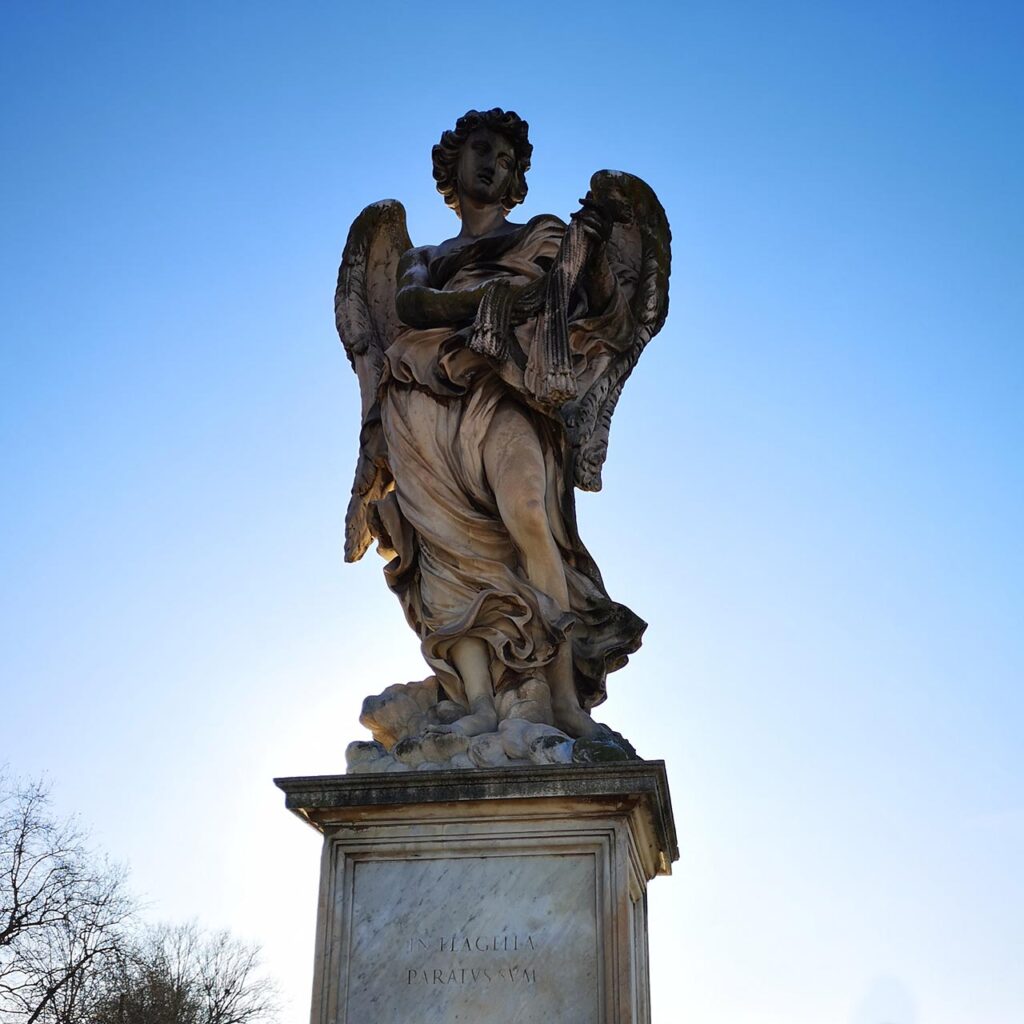
Angel with crown of thorns
The third angel, a work by Paolo Naldini completed by Bernini himself, shows the corona of thorns placed on the head of the Christ at the end of the scourging. The engraving at the base, referring to Salm 31, reads ‘In aerumna mea dum configitur spina‘, or ‘In my tribulation the thorn is thrust’.
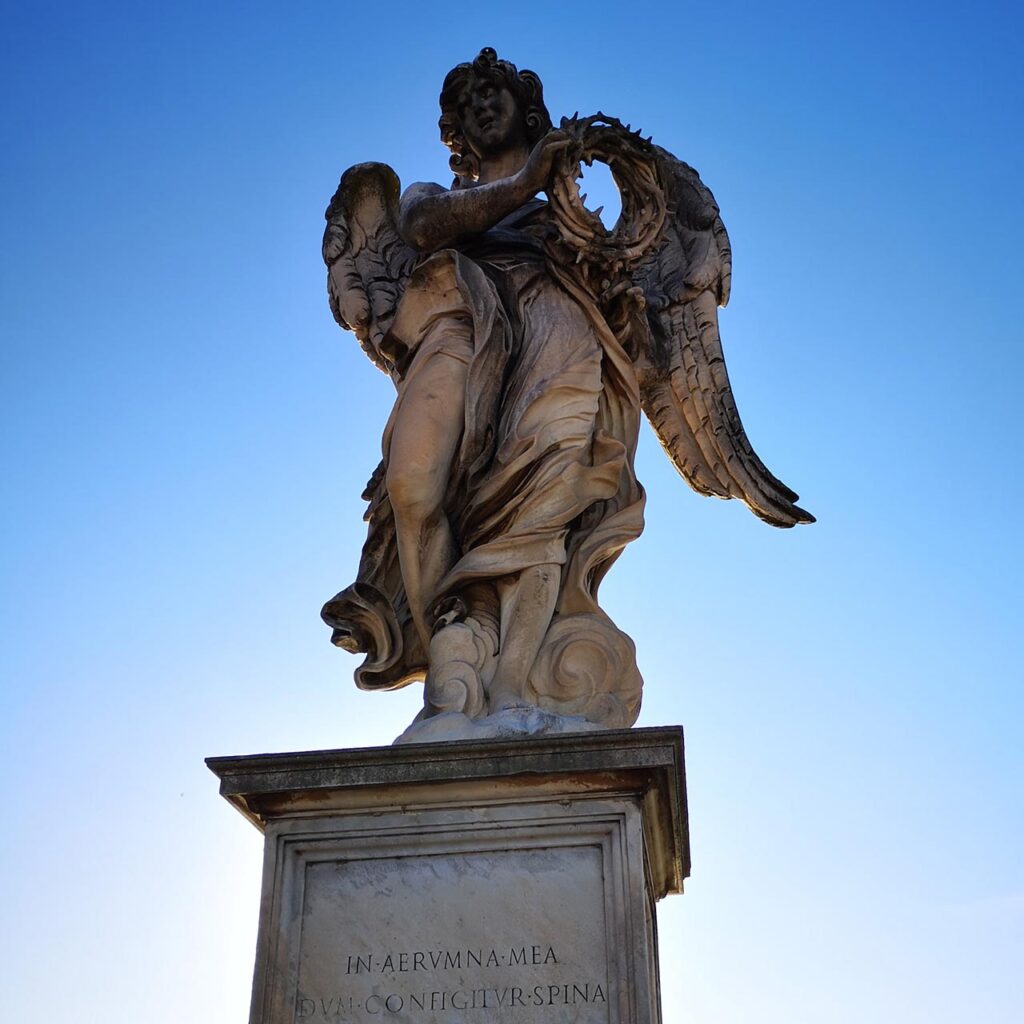
Angel with veil
The fourth angel, the work of Cosimo Fancelli, holds in his hands the Veronica Veil, the sudarium used to wipe the sweat and blood from the face of Christ. The engraving at the base, quoting “Respice faciem Christi tui“, or ‘Look upon the face of your Christ’.
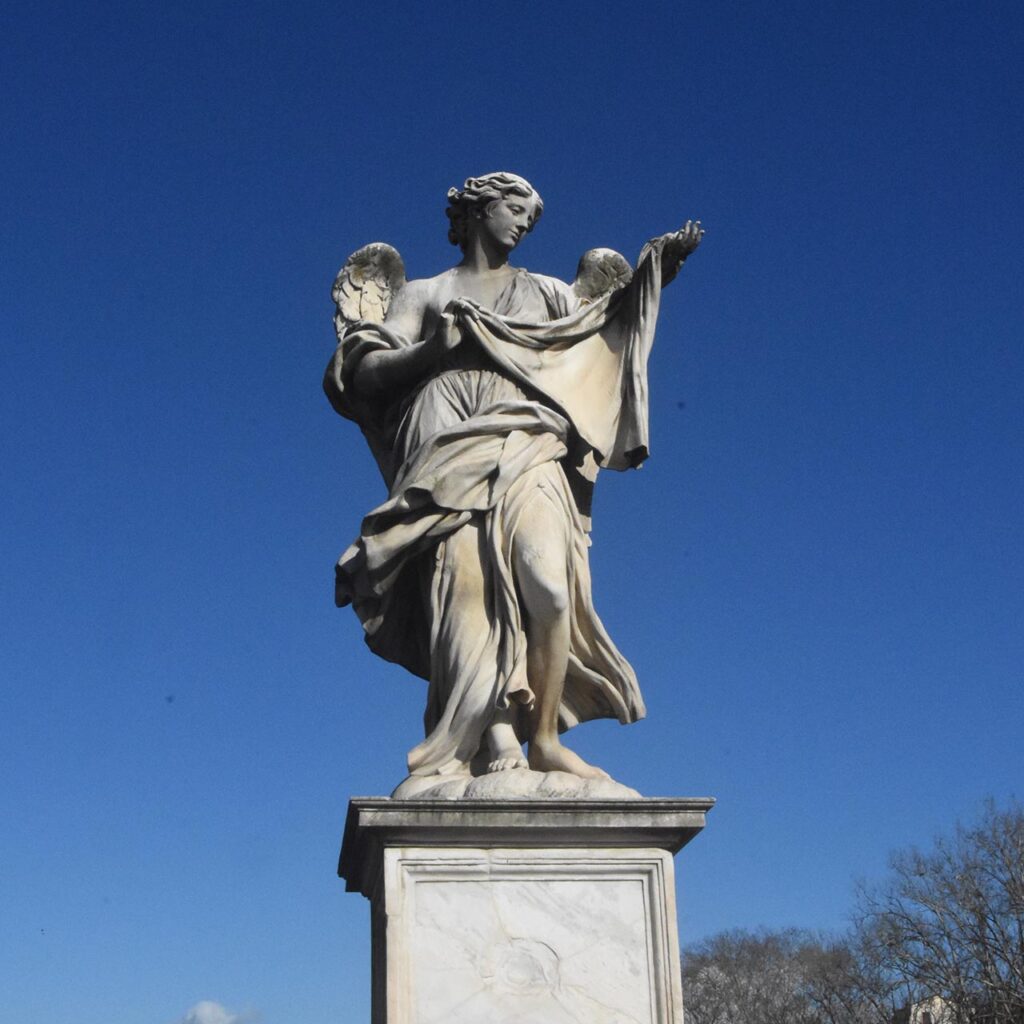
Angel with tunic and dice
The fifth angel, also by Paolo Naldini, holds the tunic of Jesus, which is said to have been played for dice by the soldiers who persecuted him. The engraving at the base, taken from the Gospel of Matthew, reads ‘Super vestem meam miserunt sortem‘, or ‘Over my robe they cast their lot’.

Angel with nails
The sixth angel, the work of Girolamo Lucenti, holds the nails that were used to crucify the Christ. The engraving at the base, taken from the Book of Zechariah, reads ‘Aspiciant ad me quem confixerunt‘, or ‘They turn their eyes to me whom they crucified’.

Angel with the cross
The seventh angel, the work of Ercole Ferrata, carries the cross that Jesus was forced to drag through the city of Jerusalem and on which he was finally crucified. The engraving at the base, quoting the Book of Isaiah, reads “Cuius principatus super humerum eius“, meaning “His kingdom is loaded on his shoulders”.

Angel with scroll
The eighth angel, a copy by Giulio Cartari of the original made by Bernini himself, shows the INRI inscription (Iesus Nazarenus Rex Iudaeorum, Jesus Nazarene King of the Jews) that was placed at the top of the crox. The engraving at the base, taken from the text of the hymn Vexilla regis, reads “Regnavit a ligno deus“, or “God reigned of the cross”.

Angel with a sponge
The ninth angel, the work of Antonio Giorgetti, shows the sponge soaked in vinegar on a stick that, according to the Gospels of Matteus and Marco, was brought to the Christ to drink him before death. The engraving at the base, quoting Salm 68, reads ‘Potaverunt me aceto‘, or ‘They gave me vinegar to drink’.
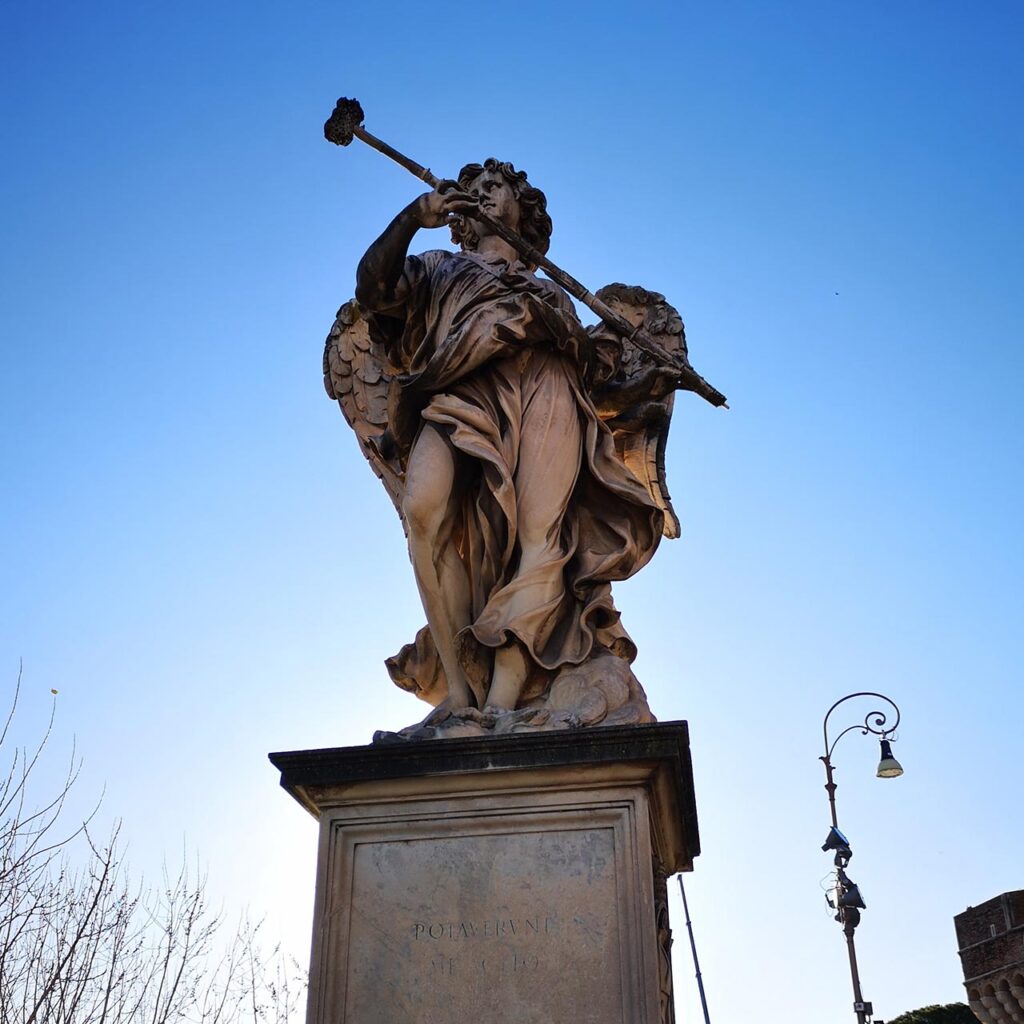
Angel with a spear
The tenth and last angel, by Domenico Guidi, holds in his hands the flint with which the Roman soldiers pierced the side of Jesus. The engraving at the base, taken from the Canticle of Songs, reads ‘Vulnerasti cor meum‘, or ‘You wounded my heart’.
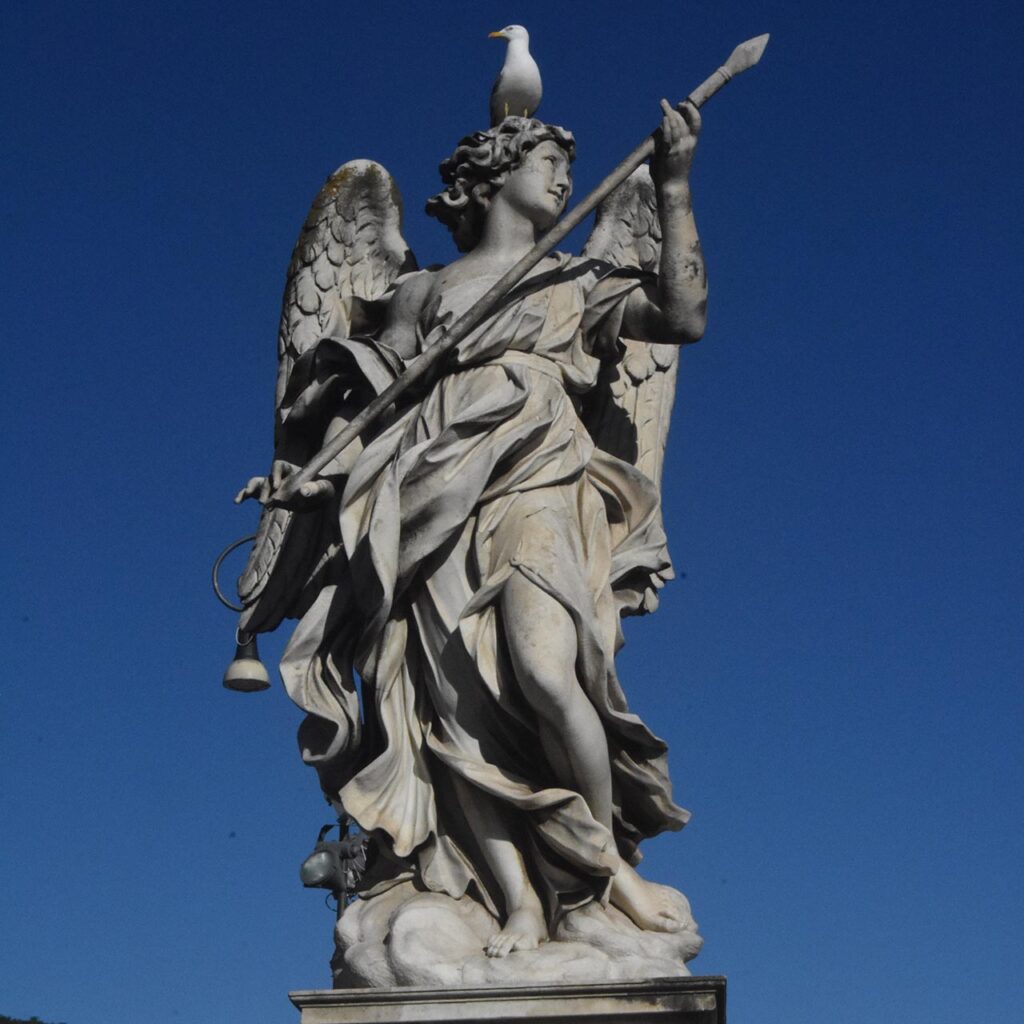

Castel Sant’Angelo Rome Tickets: Quick Access
Buy online. Choose your preferred time. Visit Rome’s Castel Sant’Angelo, Hadrian’s Tomb, the papal quarters, the fortress and much more.
You can cancel free of charge up to the day before the visit.
Ponte Sant’Angelo: Curiosities
The Ponte Sant’Angelo, like the Castle from which it takes its name, has a history stretching back thousands of years. And like all places so steeped in history, it is full of curiosities and legends. Below I will tell you the ones I found most interesting.
Dante Alighieri and the First Jubilee
The first Jubilee in history, proclaimed by Boniface VIII in 1300, ensured the St. Angelo Bridge a prominent role.
The bridge, in fact, channelled all the pilgrim traffic towards St Peter’s Basilica.
The supreme poet Dante Alighieri probably participated in the Jubilee celebrations himself.
What is certain is that he delivered to posterity a valuable description of this important moment in Christianity.
In the XVII canto of the Inferno, the poet compares the hosts of sinners to the pilgrims who walked Ponte Sant’Angelo:
Come i Roman per l’essercito molto,
l’anno del giubileo, su per lo ponte
hanno a passar la gente modo colto,
che da l’un lato tutti hanno la fronte
verso ‘l castello e vanno a Santo Pietro,
da l’altra sponda vanno verso il monte.
(Inf. XVIII, 28-33)
These verses perfectly describe how, at the time, the pilgrims’ traffic was regulated: those going to St Peter’s walked on one side of the bridge looking at the Castle, while those returning from the pilgrimage walked on the other side, with the front facing Mount Jordan.
Beatrice Cenci, the Ghost of Ponte Sant’Angelo
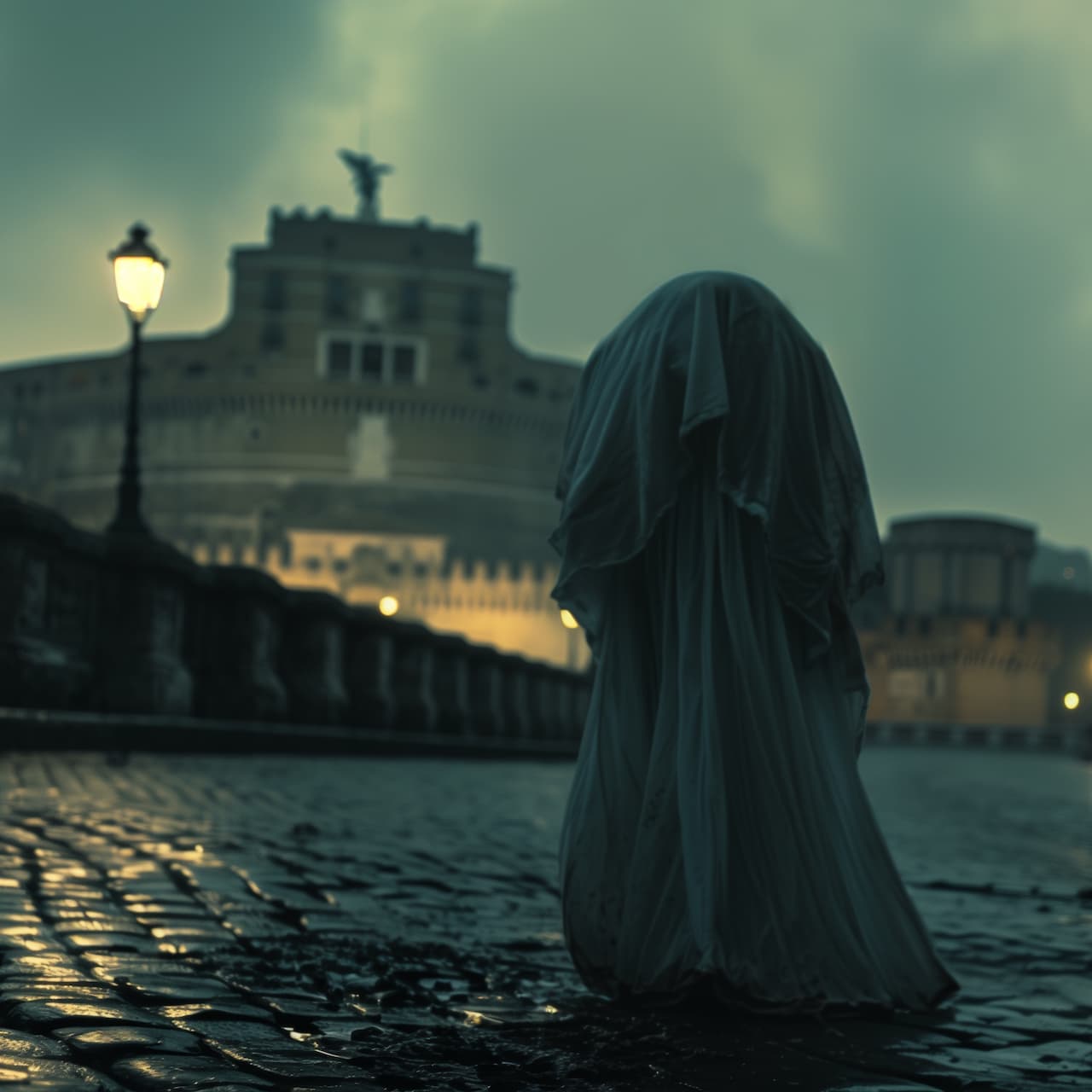
Headless Ghost by Beatrice Cenci
It is said that a ghost inhabits Ponte Sant’Angelo, and that you can see it on the night between the 10th and 11th of September each year.
The ghost is that of Beatrice Cenci, a young lady who lived in late-Renaissance Rome and is the protagonist of a tristful story that sees her, as soon as she is sixteen years old, subjected to violence by her father Francesco Cenci.
On 11 September 1599 Beatrice Cenci was decapitated in the piazza of Castel Sant’Angelo for having been behind the murder of her father.
Legend has it that his ghost still appears every year on the night between 10 and 11 September, in the act of walking from the Ponte Sant’Angelo towards the square of the gallows, holding his head in his hands.
Mastro Titta, the Executioner of Ponte Sant’Angelo
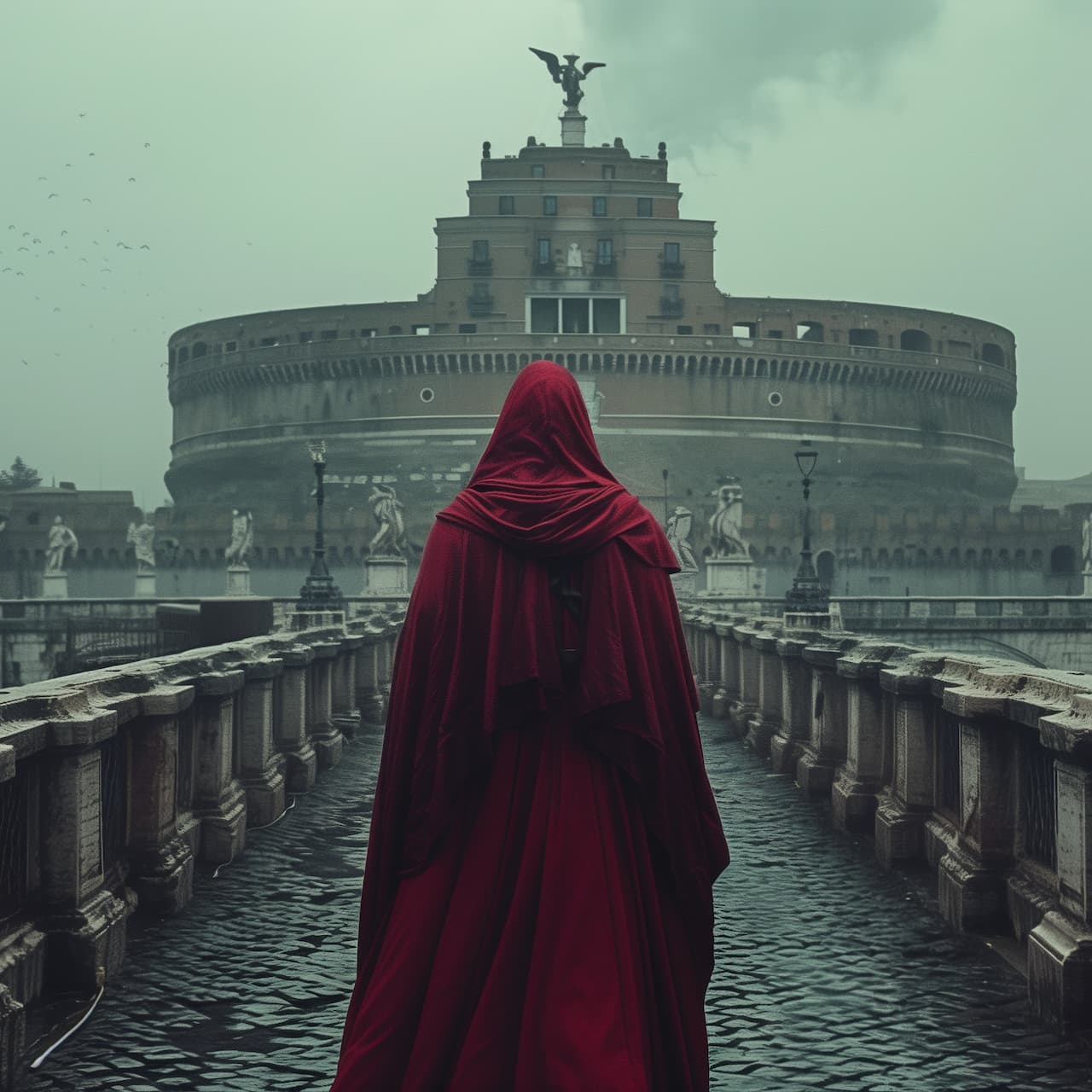
Mastro Titta, the executioner of Rome
“Mastro Titta passes the bridge.” So said the citizens of Rome when they caught sight of the buoy of the Pontiff State heading across the Ponte Elio to the Castello, well aware that someone would soon be justified.
Giovanni Battista Bugatti, known as Mastro Titta, was only one of the many executioners in the service of the Papal States, but he was also one of the most famous because of the long duration of his career: a good 68 years!
A very long career even for the present day, but let us not forget that Bugatti practised the profession between 1796 (he had started at the tender age of 17) until 1864 when, after no less than 514 executions, by then eighty-five years old he was replaced and, finally, retired.
Having become part of the Roman popular tradition, this character fuels another spectral legend: it is said that his ghost, wrapped in the red cloak he used when he practised as an executioner, can be seen walking at early dawn near many of the places of executions, starting from the Piazza di Ponte Sant’Angelo, where he is said to offer a tobacco catch to anyone he meets, as he used to do in life with the condemned. Chilling!
Castel Sant’Angelo Bridge Rome: Frequently Asked Questions
The bridge linking Piazza di Ponte S. Angelo to the lungotevere Vaticano is now called Ponte Sant’Angelo, or Ponte degli Angeli, but in the past it was known as Pons Aelius (Helios Bridge), Pons Hadriani (Hadrian’s Bridge) and Ponte di Castello, as well as Ponte San Pietro.
Yes, the bridge is pedestrian and is freely accessible, 24 hours a day, even to people with disabilities.
Ponte Sant’Angelo, also known as the Ponte degli Angeli, takes its name from the statue depicting the Archangel Michael at the top of the Castle and the ten statues of angels, bearers of the symbols of the Passion, designed by Bernini.
The angels designed by Bernini and made by his students carry the symbols of the Passion of Christ in their hands.
On the first Sunday of each month, admission to the National Museum of Castel Sant’Angelo is free and there are no reservations required.
Ponte degli Angeli Rome: Conclusions
Here we come to the end of this in-depth study on the Bridge of Angels.
We talked about the historical evolution of the bridge, starting from its very ancient Roman roots, passing through medieval history and arriving at the present day.
I have described the numerous sculptural works that adorn it, and I have reported the account of the Jubilee celebration that Dante makes in his Inferno.
I told of the ghosts that are said to inhabit that place to this day, plus I answered some of the most frequently asked questions.
If you need more information, please leave a comment below; if you would like to visit the Bridge and Castle, purchase your entrance ticket by skipping the queue at the ticket office.

Castel Sant’Angelo Rome Tickets: Quick Access
Buy online. Choose your preferred time. Visit Rome’s Castel Sant’Angelo, Hadrian’s Tomb, the papal quarters, the fortress and much more.
You can cancel free of charge up to the day before the visit.
Cover Image: Photo by Gabriella Clare Marino via Unsplash

